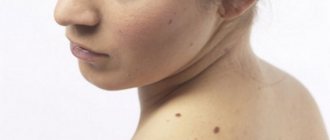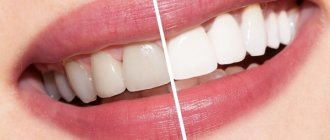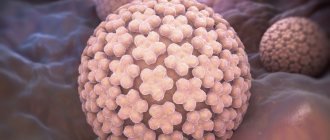Improper and irregular oral care means there is a high probability of getting some kind of infection, which can lead to gum disease. Gum papilloma is a form of oral disease that requires immediate treatment. It may also occur on the lips, tongue, larynx, and throat. Papillomas can be quite painful, and their development threatens inflammatory processes in the oral cavity.
Reasons for the formation of papillomas in the mouth and possible locations of their localization
The appearance of all types of papillomas is associated with infection of the patient with the human papillomavirus (HPV). The prevalence of this type of viral agent is very high and reaches 90% of the population in some countries. However, HPV carriage is not always accompanied by the formation of skin tumors. The virus can remain latent for a long time without manifesting itself at all. The formation of papillomas is promoted by factors such as decreased immunity, bad habits, poor nutrition and hormonal imbalance.
Science knows more than 100 types of human papillomavirus. The location of the tumor directly depends on the type of HPV. Papillomas in the mouth, covering the surface of the mucous membrane, are caused by HPV types 13 and 32, affecting various parts of the oral cavity:
- Papillomas on the tongue. The tongue most often undergoes epithelial hyperplasia, which is usually manifested by the formation of fine granularity or single tubercles of the mucous membrane of the tongue. In the first case, multiple small growths are felt as an unpleasant surface roughness, while the second type of neoplasm, being quite large, is often injured and causes its owner not only discomfort, but also pain.
Papillomas on the tongue usually appear in the tip or lateral parts of the organ. Papilloma under the tongue can also be considered a frequent occurrence. The root of the organ is least likely to suffer from such growths. The color characteristics of papilloma vary from light pink to bright red.
- Papilloma in the throat. Papillomas in the throat can remain undiagnosed for a long time, since they usually do not cause significant pain in the patient. Owners of such neoplasms of the mucous membrane note minor discomfort and sore throat, which is not given any importance.
If the papilloma increases in size, it can interfere with normal food intake and even change the voice of its owner, making it more muffled. The growth itself usually looks like a soft whitish or one-time bump with a rough surface. Papillomas on the tonsil are especially common.
- Laryngeal papilloma. One of the most unpleasant types of localization of neoplasms. The fact is that the formation of laryngeal papillomas interferes with the breathing process, which can lead to acute hypoxia. This phenomenon is especially typical for young children who cannot clearly formulate complaints about difficulty breathing.
- Papilloma on the lip. Such epidermal growth usually causes more trouble from an aesthetic point of view than from a physiological point of view. However, excessive growth of the tumor increases the risk of injury during eating or active facial expressions.
- Papilloma on the gum. Usually characterized by the absence of symptoms and any pain. If a papilloma on the gum has formed in a place that is invisible to the patient. It can only be detected by visiting a dentist.
What causes warts
The content of the article
There is a common belief that touching a frog causes warts to appear. It's a delusion. The causative agent of the disease, which results in the formation of warts, is human papillomavirus infection. According to statistics, this infection causes about 20% of all cancers.
The risk of HPV infection increases significantly:
- when using other people's personal hygiene items and items of common use;
- in public places (swimming pool, bathhouse, etc.), especially when walking there barefoot;
- in case of skin damage;
- with increased sweating of the hands and feet;
- upon contact with an infected person (handshake, sexual contact, etc.);
- when walking in tight, uncomfortable shoes that cause friction on the skin of the foot;
- when using non-sterile instruments (in a beauty salon, etc.).
The infection can remain in the human body for 3 to 6 months without showing itself in any way. Its “activator” and indirect culprit for the appearance of warts is weakened immunity.
Why are papillomas in the mouth dangerous?
The main danger of papillomas on the mucous membranes is the possibility of their malignant transformation, which is accompanied by an oncological process. It cannot be said that this probability is very high, but most doctors agree that if the epilelium grows excessively, atypical cell growth can become uncontrollable.
In addition, papillomas in the mouth are usually accompanied by constant discomfort, which is associated with the location of a large number of nerve endings and sensitive centers on the oral mucosa. Treatment of papilloma in the throat is necessary due to the likelihood of its growth with subsequent problems with speech activity.
Also, treatment of papillomas in the mouth is justified from the point of view that this particular localization is accompanied by the highest risk of injury to the neoplasm. This can happen while eating, talking, or making facial expressions. In this case, severe bleeding occurs, which is very difficult to stop. In addition, a constant humid environment with an abundance of microorganisms prevents the rapid healing of the wound surface and, on the contrary, contributes to wound infection.
Are warts always dangerous?
Most warts are completely harmless and can theoretically disappear in a few weeks or at most a month. In this case, patients are more likely to be concerned about a serious cosmetic defect, which causes psychological discomfort and interferes with leading a full lifestyle.
Warts are often painless unless they are on the soles of the feet or another part of the body that is subject to shock or constant contact. But there are cases of itching and discomfort in the affected area.
But as mentioned above, warts are viral in nature, so you cannot expect that the neoplasm will go away on its own or will not bother you for the rest of your life. Any wart should be shown to a dermatologist, and if he deems it necessary, it should be removed using one of the safe methods.
How to recognize warts: symptoms and signs
An inexperienced person may confuse warts with other skin growths, for example, moles, calluses, melanomas.
The main differences between warts and moles:
- moles have a dark or black tint, while warts have a light color;
- warts grow tightly together with the skin, moles are separate structures, as if glued to the body;
- moles are soft and smooth to the touch, warts are hard, hard and rough.
It is also easy to distinguish a wart from a callus. When pressing on the growth, painful sensations will occur, and if it peels off, traces of hemorrhages will be visible underneath it. Under the callus is new, tender skin.
You can distinguish a wart from a melanoma by color and shape. This dangerous disease is characterized by heterogeneous red and black shades, proliferation and an uneven contour.
It is not difficult for a dermatologist to make the correct diagnosis using a visual examination. But a good specialist will not be content with just a simple inspection. He will definitely use a special magnifying device - a dermatoscope. If there is a suspicion of a pathogenic process, scraping of the surface layer will be required.
In the case of anogenital warts (located around the anus and on the genitals), consultation with a gynecologist or proctologist is necessary.
Periungual plantar warts
Periungual warts are small, rough formations with cracks on the surface, located on the hands and feet of a person, namely near the nail plate or deep under it. Externally they resemble cauliflower heads.
They can be flat, pointed or hemispherical. As a rule, periungual warts are gray, but they can also be flesh-colored. They are not too dense, like simple plantar ones, but have a fairly deep root.
This disease mainly affects children and young people. The main factor in contracting the infection is skin microtraumas around the nail. At particular risk are those who bite their nails and pet stray animals, as well as people who carelessly remove cuticles, use undisinfected tools, and work in water without gloves.
This type of neoplasm does not pose a threat to human health; it is mainly only a cosmetic defect. Periungual plantar warts do not cause discomfort or pain when pressed. However, a wart under the nail is not so harmless - over time, the neoplasm provokes depletion of the nail plate and its further destruction.
In addition, various bacteria and viruses enter through cracks on the surface of the growths, which easily form due to frequent hand work, causing re-infection. Also, as warts grow, the cracks can cause pain. The cuticle is often lost and a tendency to become inflamed (paronychia) develops.
Removal of the tumor is necessary to stop the proliferation of growths, which easily spread to healthy fingers. Localization of the wart under the nail plate makes treatment and removal very difficult. When it appears in childhood or adolescence, it can go away on its own.
Laser wart removal
Today, laser surgery is one of the best ways to get rid of warts. This is a painless and safe procedure that can be used in areas of maximum sensitivity. Laser removal of tumors is very effective: the likelihood of relapse is minimal. This is significantly influenced by the severity of the disease.
Warts are removed by layer-by-layer cauterization of the affected area, thanks to which the doctor controls the depth of the effect. At the same time, the laser beam cauterizes the blood vessels, thereby preventing bleeding at the site of exposure.
Three methods of laser coagulation are common:
- Carbon dioxide (CO2) laser. Procedures using this laser are more painful. Although the CO2 laser seals the blood vessels, it also kills the wart tissue. In this process, there is a possibility of damage to healthy tissue. Wound healing usually takes longer, and scar formation is possible. The efficiency is about 70%.
- Erbium laser. It is characterized by a shorter wavelength. The likelihood of scar formation after healing is significantly reduced.
- Pulsed dye laser. This laser more effectively seals the blood vessels that feed the wart. It does not damage much of the healthy tissue like a CO2 laser does. It is also the only type of laser approved for use on children. The effectiveness of this treatment method is about 95%.
| Advantages | Flaws |
| Minimum likelihood of scar formation (depending on the degree of neglect of the pathology) | High price |
| Fast tissue healing | |
| High efficiency of the method | |
| Minimal damage to healthy tissue | |
| Speed of the procedure |
Wart removal is performed under local anesthesia. A crust remains at the cauterization site, which disappears within 14 days. After the procedure, the patient quickly returns to his normal lifestyle, provided that all doctor’s recommendations are followed.
Plantar (spike) warts
Plantar warts are a type of vulgar wart. The manifestation of the disease is most often observed in children and at the age of 20-30 years. Of all skin warts, plantar warts occur in 30%.
Warts on the soles appear as hard, round lumps with papillae in the middle. Inside the wart, characteristic black dots are visible - many small thrombosed capillaries. Along the edges there is a small roll of keratinized skin. The visible part, rising above the surface of the skin by only 1-2 mm, can reach 2 cm in diameter and is only a quarter of the total size of the plantar wart, which mainly forms in the deep layers of the epithelium (skin).
Externally, the spine resembles a callus. A plantar wart can be differentiated (distinguished) from a callus by the visible interruption of the skin pattern in accordance with the wart.
This type of neoplasm usually affects the feet (sole, sides and toes), and less commonly the palms. They appear on the skin as small whitish, pinpoint skin lesions, sometimes itchy. Over time, their surface becomes rougher and changes color - from yellow to dark brown.
Plantar warts themselves do not pose a threat to health, but when walking they cause a person significant discomfort, cause pain, which often intensifies, and can even bleed. This is due to the location of the tumor and the specifics of its growth. Since the spine grows inward, the weight of the body when walking compresses the pain receptors.
The incubation period of the disease ranges from several days to several years. The infection enters the body and goes into waiting mode for a favorable environment to activate. Plantar warts regress without treatment in 50% of cases. But this process lasts from 8 months to one and a half years.
Without treatment, plantar warts will enlarge and multiply, even to the point of producing large clusters of tumors. This can even lead to temporary loss of a person's ability to work due to unbearable pain that prevents walking.
Based on the characteristics of the lesion and its location, plantar warts are divided into 3 types:
- simple;
- periungual;
- mosaic.
Treatment of warts in St. Petersburg
Treating warts requires a lot of patience. Warts may appear and disappear for no apparent reason or for reasons that are difficult to identify. High infectivity and autoculation of warts are arguments in favor of removal.
There are many different treatment methods. Therapeutic choices differ depending on the type of wart, its location, depth, number and extent of the affected area of skin.
Treatment for warts can produce very different results. Some warts respond to treatment while others do not, even if it is given to the same person.
Treatment often requires repetition over several weeks, months and in extreme cases even years before success is achieved. But in any case, wart removal should be performed in a clinic by a dermatologist. Self-medication is highly discouraged, as the consequences may be irreparable.
The most gentle and universal ways to get rid of warts of all types are laser and radio wave therapy.









